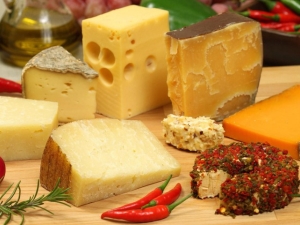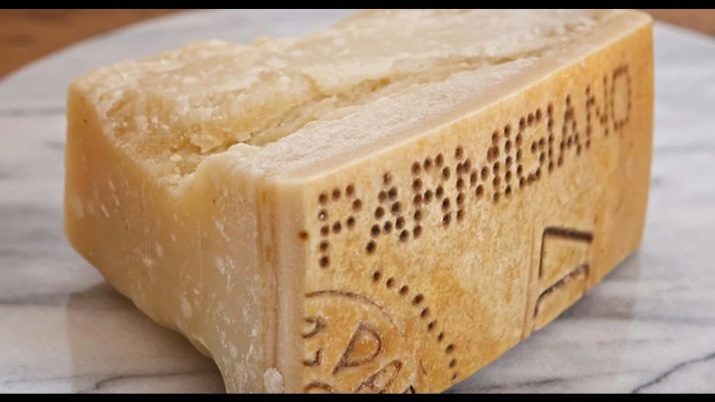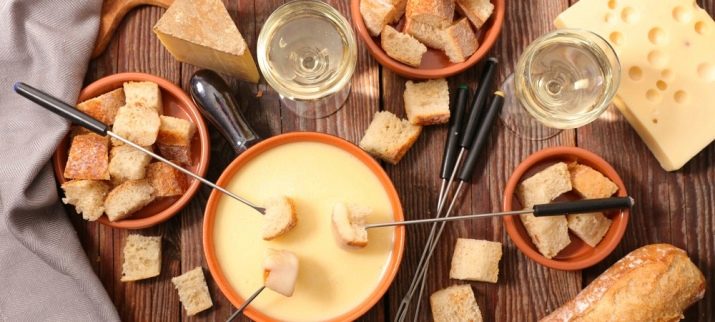Calorie and nutritional value of cheese

Cheese is a popular gastronomic product, widely used in the preparation of many dishes from cold snacks to desserts and pastries.But in the context of the food embargo, it became almost impossible for lovers of flavored delicacy to choose a high-quality and tasty product. Many varieties simply disappeared from store shelves, or were replaced by domestic counterparts. This article describes how to choose the right and tasty cheese in the store and what you should pay attention to.
Composition
Many countries are engaged in cheese production and today there are about 2 thousand different varieties in the world. And although the ingredients and recipes may differ, one main ingredient remains unchanged - this is milk. True, cow, sheep, goat, and even soy milk can be used as the basis of cheese.
Each variety of aromatic delicacy contains a large number of nutrients and elements. Among them the following vitamins are very important.
- BUT - are responsible for maintaining immunity and the normal functioning of the body, 100 grams of cheese contains about 32% of the person’s daily allowance.
- D - is responsible for regulating the metabolism of calcium and phosphorus, and also promotes the elimination of heavy metals from the body and normalizes the work of the heart.
- WITH - in combination with vitamins of group A helps to prevent colds.
- E - it is necessary in the treatment of the reproductive system, but in modern pharmacology it is included only in the composition of vitamin complexes and dietary supplements, and in food products it is found in large quantities in cheeses.
- PP - 100 grams of cheese contains 30% of the recommended daily intake.
- B1, B3, B5, B6, B7 and B12 - necessary for energy production in the body, and also participate in the processes of tissue respiration.
No less significant are minerals and acids.
- Macro elements calcium, iodine, zinc, copper, chromium, magnesium, iron and phosphorus - play an important role in the treatment of many diseases and recovery from complex injuries and burns, reduce muscle pain during periods of intense and intense training. About 30% of the daily requirement of macronutrients and nutrients is contained in 100 grams of cheese.
- Tryptophan - helps fight stress and insomnia.
- Omega-3 and Omega-9 unsaturated fatty acids - help reduce the risk of developing diabetes.
There is a large number of varieties, but all cheeses can be divided into several categories.
- Hard varieties - the process of cooking and ripening is very long and can reach 6 months. First, the milk is mixed with sourdough, then the resulting mixture is boiled in a metal container until cooked. After that, the cheese heads are under pressure for a long time. This category includes: Parmesan, Russian, Dutch, cheddar.
- Soft varieties - have a soft pasty consistency. This category includes: mozzarella, brie, roquefort, punches.
- Brine varieties - the peculiarity of such cheeses lies in the method of aging and storage, and throughout this time the product is in brine. Therefore, the finished product has no crust, and the color depends on the variety and can be from white to light yellow. But the consistency is almost always the same - a light cut can be with a light, crumbly or layered structure. These varieties include: Adyghe, feta, white cheese, suluguni.
- Whey varieties - Basis uses cream cheese from hard varieties. After a long production phase, popular cheeses are obtained: ricotta, brunost and others.
In addition, cheeses are classified by production technology, maturity and composition. Therefore, there is no single generally accepted classification. The same variety may fall under different categories. But it is also understood that all types of cheeses have different caloric and nutritional value.
Calories
Each variety of cheese has a certain calorie content, so people who strictly follow the diet, you need to pay attention to it.For example, Dutch, Kostroma, Poshekhonsky and Smetankovy cheeses have a greater amount of fat, compared to Mozzarella or Ricotta, and the calorie content of the first can reach 350 kcal per 100 grams.
Among our compatriots, one of the most popular is Russian cheese - the product is not the most expensive, falling into the category of affordable. In addition, many manufacturers offer this variety, however, the recipe remains unchanged, so the taste of cheese is always the same.
Russian cheese has a pleasant yellow color with a large number of small eyes on the cut, and it has a slightly sour taste. The fat content of such Russian cheese is about 45-50%. But in one small piece the calorie content will be within the accepted norm, therefore it is possible to recommend to the fans of hard sorts of domestic cheeses a decrease in their daily servings.
It is impossible not to mention another popular and world-famous cheese - Parmesan. In Italy, it has a more beautiful name - Parmigiano Reggiano. It has a spicy and unforgettable finish. The maturation period of one head is 6 months or more. The slice structure has a jagged edge and a tiny texture. The nutritional value of parmesan per 100 g is about 400 kcal.
For low-calorie cheeses are the following varieties.
Mozzarella
Mozzarella is the main ingredient of any pizza. It is difficult to characterize the taste of mozzarella, we can say that it is more neutral than pronounced. But the specific texture made mozzarella an ideal ingredient for pies and pizza - when heated, the cheese drags.
But mozzarella is also used in cold appetizers and salads - another popular dish is caprese salad, in which fresh tomatoes alternate with delicious slices of fresh mozzarella, decorated with green basil, generously flavored with olive oil and balsamic vinegar. Mozzarella has a small amount of fat - only 25%.
Feta
Feta appeared in sunny Greece and for a long time produced according to traditional centuries-old recipes. The basis is used exclusively sheep or goat milk. At the same time, Feta is an excellent source of protein - about 17 g, and fat - 24 g.
White cheese
White cheese resembles natural cottage cheese in color, and its taste is a bit similar to feta. This is an excellent component for the preparation of diet snacks, salads, main dishes and pastries, since the fat content of 100 g of cheese is only 20%.
Tofu
Honestly, it is difficult to call Tofu cheese. Tofu is based on soy milk, which is why vegetarian menus are often used as a substitute for protein products based on natural milk.
Homeland is the east - Japan and China, and, according to local residents, in Tofu lies the secret of longevity and good health. The taste of Tofu is more neutral, the structure resembles silk and soft yogurt.
Ricotta
The homeland of ricotta is Italy, this soft and gentle curd cheese, to taste is very similar to sweet yogurt. Ricotta is made from whey, which remains after cooking other varieties of cheese.
Both cow and sheep milk can be used as the basis, but the fat content of such products is significantly different. The percentage of Ricotta fat in cow's milk is 8%, and in sheep's milk - 27%.
Adygei
Adygei belongs to the category of soft varieties, it tastes like a cross between a curd with a soft milky aroma and hard cheese. Soft texture and delicate salty taste - these are the distinctive features of the Adygei cheese.
This variety is recommended to include in the diet during the diet. It can also be used in the preparation of some less calorie dishes. Adyghe cheese blends perfectly with fresh vegetables and, for example, is an excellent substitute for feta cheese in a Greek salad.
Some types of cheeses, for example, Chechil, have a low calorie content, but due to the high salt content, it is not recommended to use this variety in large quantities. And other cheeses with a rate of 35% and 40% do not harm the figure, if used in moderation.
The nutritional value
Nutritional value depends on the type of cheese, which differ in the method of preparation, ingredients, amount of fat and calories. But in any form contains a large number of proteins. And also important to pay attention to the amount of fat. A small percentage of fat is found in the following grades.
Suluguni
Suluguni - Georgian pickled cheese with an elastic and dense texture. The production technology is similar to the Italian varieties.
The basis includes cow, sheep, goat and buffalo milk. That is why the taste of Suluguni is very delicate, with a pleasant milky aroma and a slight salty aftertaste. In 100 grams of ready-made suluguni the optimal amount of BJU: proteins - 19.5 grams., Fats - 22 grams, carbohydrates are absent.
Dor blue
Dor Blue - blue cheese with mold is an exquisite delicacy for real cheese gourmets. Delicate and fragrant head hidden behind a solid, moldy crust. The taste of soft cheese is unforgettable - spicy and slightly salty.
The smell of Dor Blue is very specific, which is why fans of this variety are not so many among our compatriots. Dor Blue is rich in penicillin and amino acids that have a beneficial effect on the body. The percentage of fat in 100 grams of the product is 30 g.
Kurt
Kurt - hard curd cheese in the form of balls. Kurt is widely known for its nomadic peoples, and today it is a national dish in the countries of Central and Central Asia.
Very nutritious and high-calorie, but has a low percentage of fat - only 16 g.
Cheddar
Cheddar occupies a leading position among the world's famous cheeses. Homeland is England, the province of Cheddar of the same name. Cheese has a bright rich yellow color, which is closer even to sunny orange.
Maturation can take from 2 months to six months. The composition of Cheddar includes the optimal amount of fat - 30 g, which allows the use of this product even in the diet, but in small quantities.
Amber
Amber - gentle and tasty semi-hard cheese belongs to the category of low-fat varieties - only 10 g. It appeared in Sweden at the beginning of the XIX century. Amber's distinctive feature is small and even round holes at the head section.
It goes well with nuts and sour fruits (pears, grapes) as a snack, but can also be used in the preparation of main hot dishes.
Any types of cheeses have useful properties, therefore, recommended by nutritionists for daily use in small quantities.
Useful properties can be noted in the following paragraphs.
- Calcium-rich cheese is very useful for the formation and strengthening of teeth and bones. According to dentists, frequent use of cheeses increases the strength of tooth enamel and reduces the likelihood of plaque.
- And also, according to scientists, cheese helps reduce the risk of cancer. Linoleic acid, sphingolipids and B vitamins that are part of any variety help the body fight the negative effects of free radicals.
- Cheese with mold facilitates the processes of digestion and has a beneficial effect on the bowels.
- Useful elements in the composition of the cheese contribute to the stable operation of the immune system of the body, calms the nervous system and normalizes pressure.
- Eating cheese helps preserve beauty and prolong youth. Useful substances contained in all varieties help to improve the structure of hair, nails and skin.
Use in dietary nutrition
Cheese is an excellent source of protein, calcium and unsaturated fats. You can eat cheese as a snack, make sandwiches, cold and main dishes.We offer several simple and useful dietary recipes that can be prepared every day.
Cheese pasta
Pasta with cheese is a great option for a full meal rich in slow carbohydrates and proteins. In the fitness menu, pasta made from durum wheat can be replaced with wholegrain, rice or buckwheat.
It is necessary to boil the pasta in salted water to the state of al-dente. And then drain and sprinkle hot pasta with a small amount of olive oil. Add finely grated hard cheese and garnish with fresh basil.
Such a dish not only does not harm the figure, but also charges the body with energy for the whole day.
Cheese cream soup
Cheese puree soup - for the preparation of this aromatic dish you will need: turkey fillet, potatoes, onions, cauliflower, carrots, bay leaf, spices and soft processed cheese. Put the meat in a pan with hot water and boil until ready, then add potatoes, onions and carrots to the broth.
Then you can add cauliflower blossoms, and then carefully chop the contents to a state of mashed potatoes. After that, you can add the finished and shredded meat, bay leaf and spices.
The last ingredient is added cheese - it will give the hot soup a pleasant texture and delicate taste. Serve the soup with croutons or toast.
Fondue
Fondue is a real joy for a cheese gourmet. It may seem that diet fondue is something of a fantasy. But in fact, you can cook a less-calorie meal, using only low-fat cheeses. In addition, you will need milk, two cloves of garlic, nutmeg, lemon juice, dried herbs and ground pepper. Put grated cheese in a fondue pot and put the saucepan on a slow fire, gently stirring, bring the cheese to a homogeneous mass. Gradually add the remaining ingredients.
To make fondue more liquid, you need to add more milk, and, conversely, to make it thicker and more saturated - less liquid. When cooking fondue, you can fantasize and add various ingredients, such as fresh greens and finely chopped nuts.
To make the finished dish more dietary, you can serve fondue with slices of whole-grain bread, fresh vegetables, boiled turkey fillet, or small meatballs made from white meat.
Cheesecake
Cheese biscuits - ideal for breakfast or snack. As a basis, it is recommended to use oatmeal flour, as well as chicken egg, baking powder, salt and finely grated hard cheese.
Mix all ingredients and leave the dough to rest for 30 minutes. Then cover the baking sheet with parchment and form small-sized cookies with your hands. Bake at 180 degrees for 30 minutes.
If the crispy and fragrant cookies are ready, you can serve it with hot tea.
Puff buns
Puff buns with cheese are cooked in 15 minutes and are eaten as fast. For cooking, you will need puff pastry, which you need to roll into small layers and smear with curd cheese. Then roll the dough into a roll and cut into 2 cm slices.
Place the buns on a baking sheet with parchment paper and sprinkle with grated cheese on top. Bake at 160 degrees until cooked.
Chicken cutlets with cheese and fresh herbs
Chopped chicken cutlets with cheese and fresh herbs - a very quick and tasty recipe for every day. For cooking you will need: chicken fillet, onions, semolina, chicken eggs and fresh greens. First you need to prepare the meat - cut the fillets into small cubes, chop the cheese, chop the onions and greens.
Mix all ingredients in a deep bowl and add eggs and spices. Pay attention to this fact: the saltier the cheese, the less salt should be used. To give the desired consistency of minced meat, you need to add a little semolina.
It is recommended to cook the patties in a dry nonstick frying pan, frying for 4 minutes on each side until golden brown.
Cheese Baskets for Cold Appetizers
Cheese can be used not only as a main ingredient, but can also be an excellent option for a spectacular presentation of a salad or main course. And to cook edible cheese baskets is very simple. To do this, chop the hard cheese on a fine grater and lay a thin layer on a flat plate.
Then put the plate in the microwave for 10-15 seconds. After that, get the melted cheese and place the hot circle on the glass so that the middle of the pancake is located exactly on the base of the glass. Such a design of glass and cheese pancake must be removed in the refrigerator for 10 minutes until fully cured.
After that, the finished basket must be carefully removed from the glass and used as a plate for vegetable salad.
But you should not be limited to these recipes. Hot pizza with mozzarella will conquer the heart of any gourmet, and appetizing crispy cheese on meat in French will make the main dish a safe option on the festive table.
But despite the large number of positive properties, the frequent use of some varieties of cheese can cause disruptions of the body. That is why it is necessary to limit consumption in some cases.
- Pregnant and lactating young mothers should abandon the use of cheese with mold and some varieties, based on non-pasteurized milk - live bacteria can cause infectious diseases in both mother and baby. These varieties include: Feta, Roquefort, Dor Blue. It is also not recommended to include in the diet of the baby under the age of 1 year any cheese.
- People who are on a strict or obese diet should not eat fatty cheese daily. It is recommended to replace solid and fat varieties with curd and pickle.
- And those prone to allergies need to carefully study the composition of the cheeses, since some varieties may contain food and chemical additives.
- In case of diabetes, experts recommend to use brine varieties, for example, Adygea or Feta, as the percentage of milk sugar in these cheeses is about 3%.
How to make cheese on their own, see the next video.













































